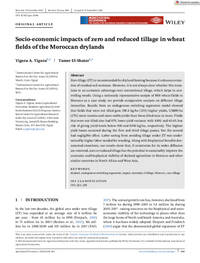Socio-economic impacts of zero and reduced tillage in wheat fields of the Moroccan drylands

Authors:
Zero tillage (ZT) is recommended for dryland farming because it enhances retention
of residual soil moisture. However, it is not always clear whether this translates
to an economic advantage over conventional tillage, which helps in controlling
weeds. Using a nationally representative sample of 1901 wheat fields in
Morocco as a case study, we provide comparative analysis on different tillage
intensities. Results from an endogenous switching regression model showed
that fields that were not tilled gave 298.6 kg/ha (23%) higher yields, US$89/ha
(27%) more income and more stable yields than those tilled once or more. Fields
that were not tilled also had 87% lower yield variance with 100% and 65.6% less
risk of giving yield levels below 500 and 1000 kg/ha, respectively. The highest
yield losses occurred during the first and third tillage passes, but the second
had negligible effect. Labor saving from avoiding tillage under ZT was undermined
by higher labor needed for weeding. Along with biophysical benefits documented
elsewhere, our results show that, if constraints for its wider diffusion
are removed, zero or reduced tillage has the potential to sustainably improve the
economic and biophysical viability of dryland agriculture in Morocco and other
similar countries in North Africa andWest Asia.
